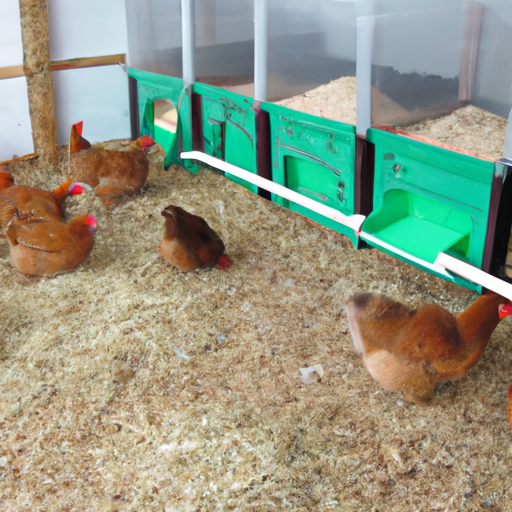
If you’re a chicken enthusiast and constantly looking for ways to improve their coop, you may have come across the term “deep litter.” But what exactly is deep litter and is it beneficial for your feathery friends? This article aims to explore the pros and cons of using deep litter in the coop, shedding light on whether this practice is the right choice for you and your beloved chickens. Whether you’re new to the concept or just looking for more information, read on to discover the potential advantages and disadvantages of implementing deep litter in your coop.
Pros of Using Deep Litter
1. Natural Composting
One of the biggest advantages of using deep litter in the coop is that it promotes natural composting. As the bedding material, such as straw, wood shavings, or dried leaves, accumulates over time, it begins to break down and decompose. This process creates heat, which helps to regulate the temperature inside the coop, especially during colder months. Additionally, the decomposing organic matter creates rich, nutrient-dense compost that can be used in your garden or flower beds.
2. Improved Insulation
Deep litter bedding also provides improved insulation for your chickens. As the bedding material decomposes, it forms a thick layer that acts as a natural insulator, trapping heat during cold weather and keeping the coop cooler during hot weather. This natural insulation helps to maintain a consistent temperature inside the coop, creating a comfortable environment for your chickens.
3. Reduced Odor
Another benefit of using deep litter is the reduction of odor in the coop. The decomposition process of the bedding material helps to break down and neutralize the odors produced by chicken droppings. Unlike traditional coop cleaning methods, where the bedding is completely removed and replaced, deep litter management allows the beneficial microorganisms to continuously work on breaking down the waste, resulting in a less offensive smell.
4. Enhanced Biosecurity
Deep litter bedding can also contribute to enhanced biosecurity for your flock. The constant decomposition and breakdown of organic matter helps to create an environment that is unfavorable for harmful bacteria and pathogens, reducing the risk of disease transmission among your chickens. Additionally, the thick layer of bedding acts as a physical barrier between the chickens and the ground, minimizing direct contact with potential sources of contamination.
5. Dust Control
Using deep litter can help control dust in the coop, which is particularly beneficial for your chickens’ respiratory health. The bedding material acts as a natural filter, trapping dust particles and preventing them from becoming airborne. This reduces the amount of dust that your chickens are exposed to, minimizing the risk of respiratory issues and improving overall air quality in the coop.
Cons of Using Deep Litter
1. Initial Setup
One of the drawbacks of using deep litter in the coop is the initial setup process. It requires a significant amount of bedding material, which can be expensive depending on the size of your coop and the availability of suitable bedding options in your area. Additionally, you need to properly prepare the coop by cleaning it thoroughly and ensuring proper ventilation before adding the deep litter bedding.
2. Increased Moisture
While deep litter can help regulate moisture levels in the coop, it can also lead to increased moisture if not managed properly. Excessive moisture in the bedding can create a damp environment, which can promote the growth of harmful bacteria and fungi. This can potentially lead to health issues for your chickens, such as respiratory infections and foot problems. Regular monitoring and proper management are essential to prevent excessive moisture buildup.
3. Mites and Parasites
Deep litter bedding can attract mites and parasites, posing a potential risk to your flock. The warm and moist environment created by the decomposing bedding can be attractive to these pests. Regular cleaning and thorough inspections are necessary to detect and address any mite or parasite infestations promptly. Implementing preventive measures, such as regular dust bathing areas and natural pest control methods, can help minimize the risk of infestations.
4. Potential Ammonia Build-up
If not properly managed, deep litter can lead to an ammonia build-up in the coop. Ammonia is a toxic gas that is released as chicken droppings break down. High levels of ammonia can irritate the respiratory system of your chickens and contribute to respiratory issues. Regularly turning and aerating the deep litter bedding, along with proper ventilation in the coop, can help prevent ammonia build-up and promote good air quality.
5. Difficult Monitoring
Monitoring the condition of the deep litter bedding can be challenging. Unlike traditional coop cleaning methods where the bedding is completely removed and replaced, deep litter management requires monitoring the moisture levels, ammonia levels, and overall cleanliness of the bedding. This can be time-consuming and may require more frequent cleaning and maintenance compared to other coop cleaning methods.
In conclusion, using deep litter in the coop has several benefits, including natural composting, improved insulation, reduced odor, enhanced biosecurity, and dust control. However, it is important to consider the cons as well, such as the initial setup process, increased moisture, the risk of mites and parasites, potential ammonia build-up, and difficult monitoring. With proper management and regular maintenance, deep litter can be a viable and sustainable bedding option for your chicken coop.






